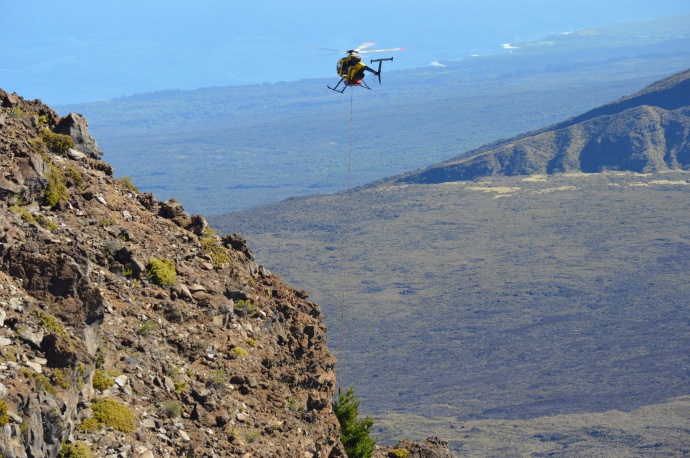Haleakalā National Park to Begin Pine Control Project

Helicopters will deliver an herbicide to invasive pines in Haleakala Crater by precisely spraying individual trees. NPS photo.
By Maui Now Staff
Haleakalā National Park officials held a public meeting on Thursday, Aug. 20, to outline a pine control project scheduled for September through October of this year. The project will target over 3,000 invasive pine trees in Haleakalā Crater.
Park biologists typically control pine trees by removing them. The remaining trees, however, are located on terrain and cliffs that are too steep for park staff to access safely.
The new project will utilize contracted helicopters to deliver an herbicide to the pines by precisely spraying individual trees. The spray is targeted by use of a spray nozzle; droplet size can be adjusted to reduce any herbicide drift.

In December 2014, the National Park Service conducted a pilot pine control project, successfully targeting 185 trees. NPS photo.
The mixture is a combination of water (93%), glyphosate (5%), aminopyralid (.1%) and vegetable oil (1%). The composition and weight of the oil allows the mixture to bind to and become absorbed by each pine.
The herbicides degrade within 30 days.
If left untreated, park biologists believe the entire crater would eventually become a pine forest. The pines displace endemic and endangered species. They also change soil chemistry and increase the potential for wildfire in habitats not adapted to fire.
The project will conserve the crater views and protect species that depend on native habitats for survival.
Park biologists believe that time is of the essence; the project must occur before the pines mature and spread.
In 2007, the Poli Poli fire burned over 600 acres of pine-forested land outside of the park. That fire caused mature pines to release their seeds, which Kona winds spread across portions of East Maui, including Haleakalā Crater.
Today, thousands of non-native Monterey pine, Mexican weeping pine and maritime pine grow inside the park. In contrast, between 1982 and 2006, only 22 pines had to be removed from the crater.
The targeted herbicide spray method developed with researchers from the University of Hawai‘i has been successfully used elsewhere in the state.
Before approving the project, the National Park Service completed National Environmental Policy Act and Endangered Species Act compliance.
In December 2014, the park conducted a pilot pine control project and successfully targeted 185 trees.
The next phase of the project will occur during four to seven days in September-October of this year (weather permitting) on the remote Hāna Peak and the western crater wall.
No trail, campground, road, cabin, or other closures will occur, the park service said.










